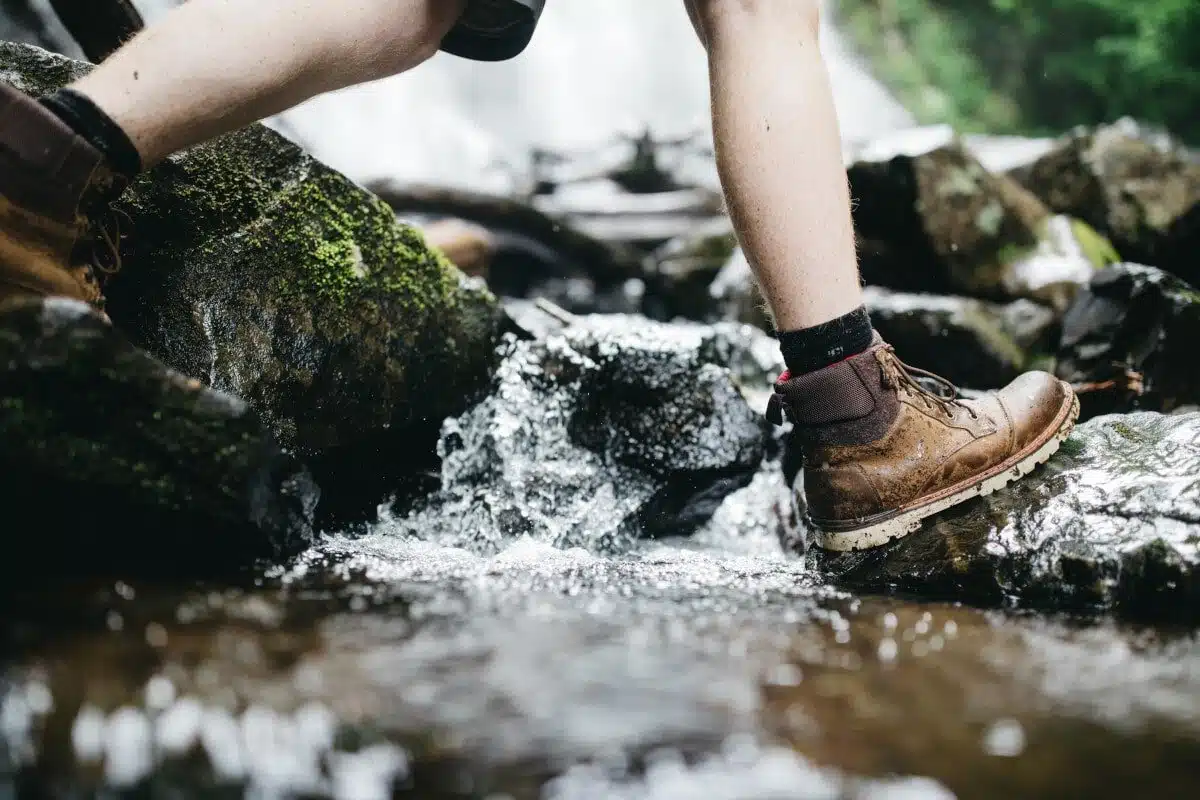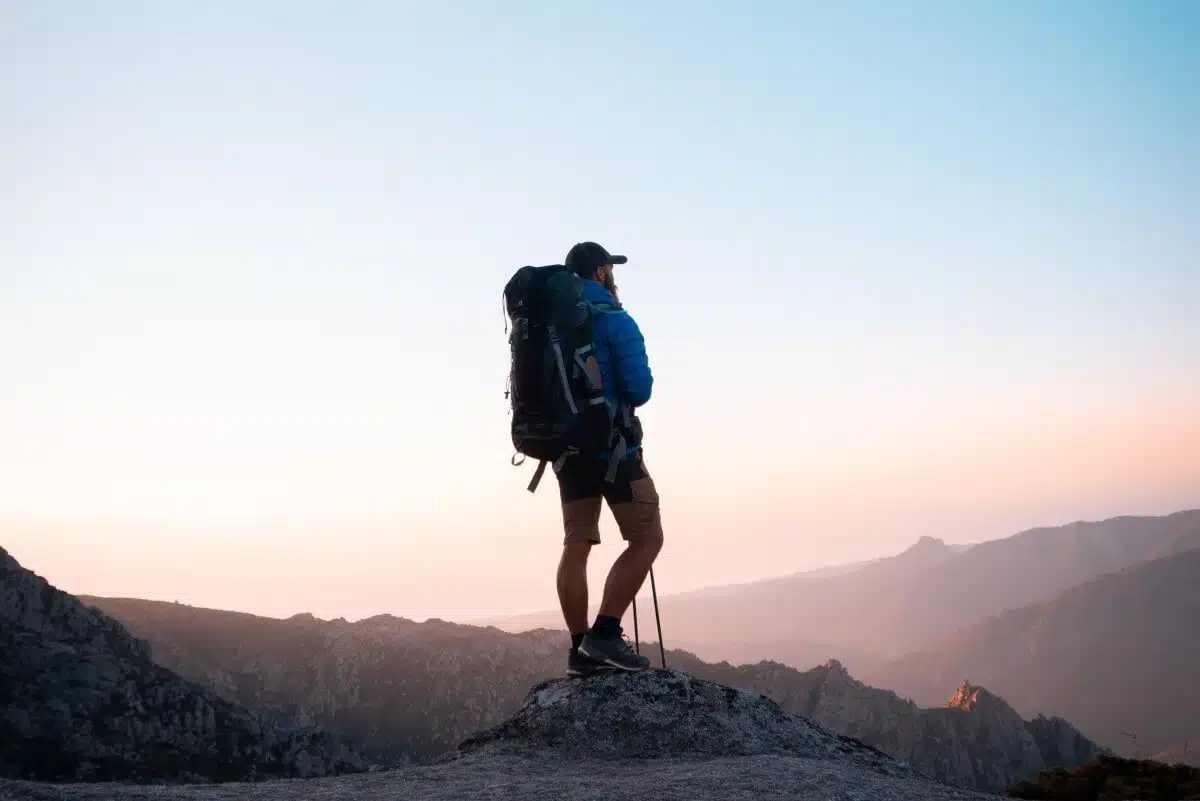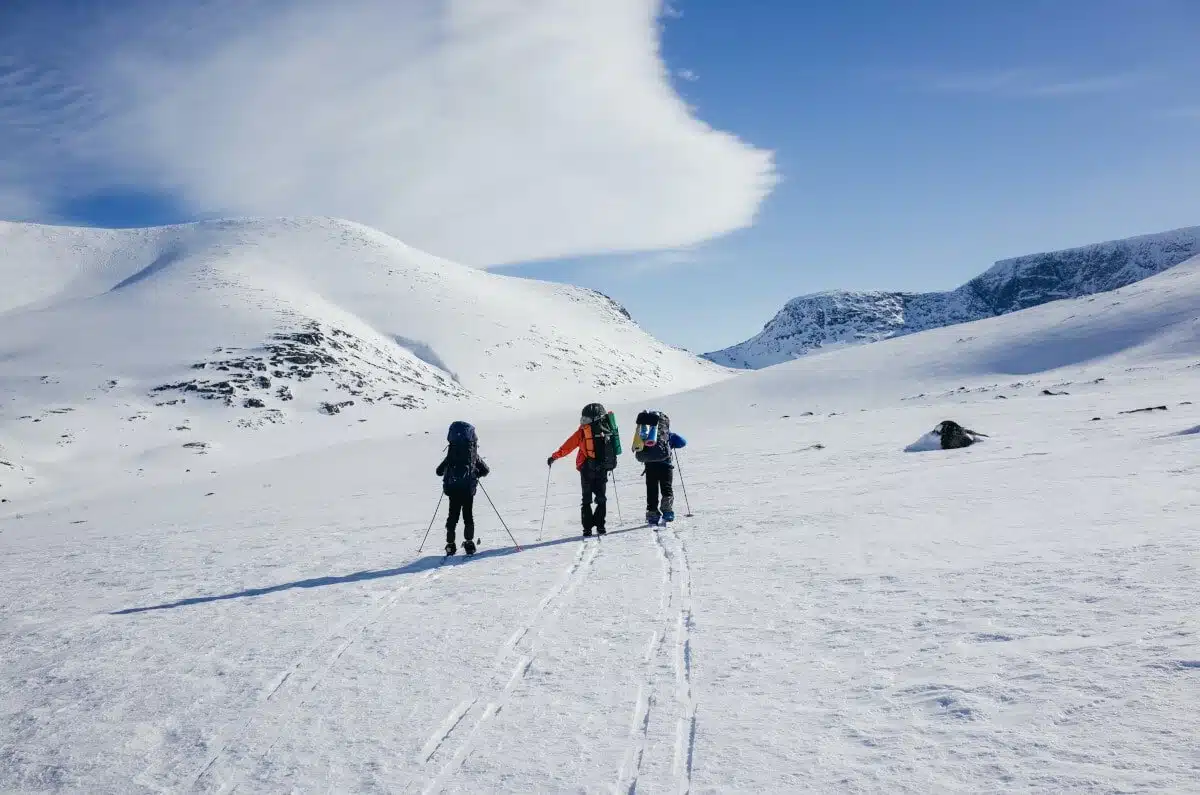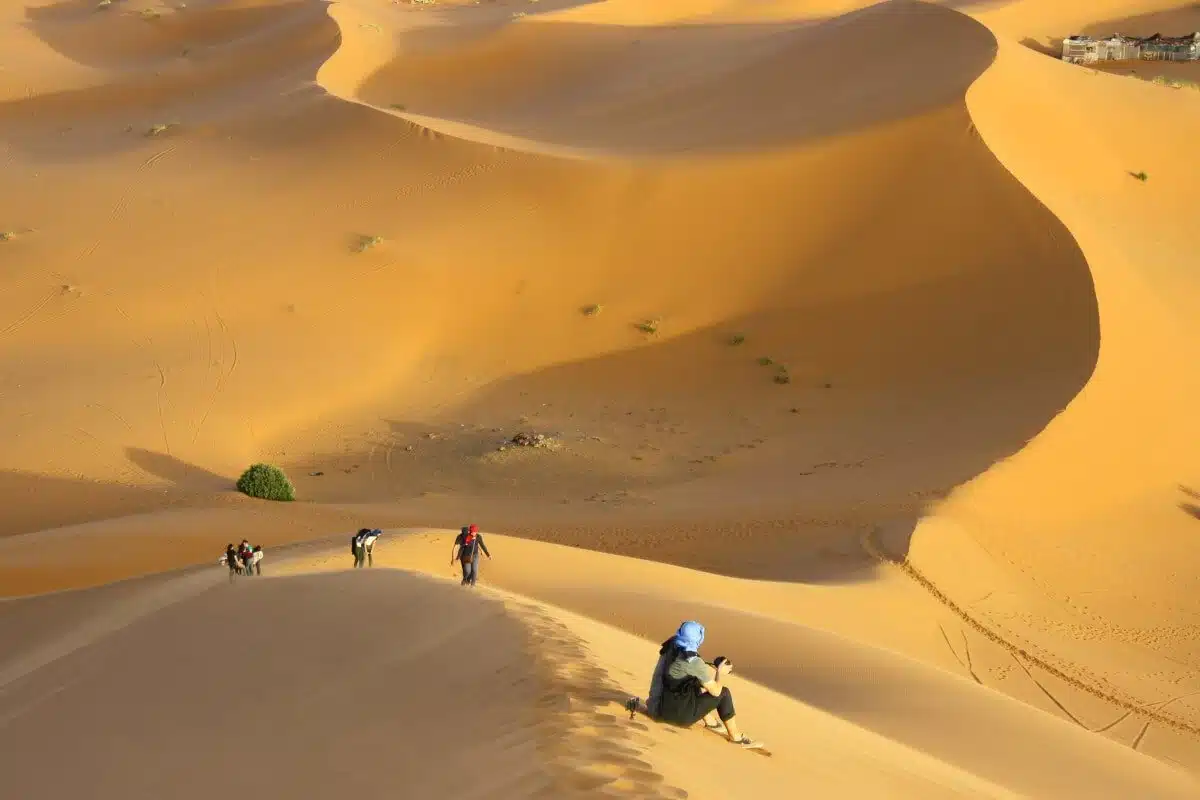
Wondering what to wear hiking? I hope this guide to clothes for hiking helps!
Knowing what to wear hiking can mean the difference between joy and suffering!
After all, wearing the wrong clothes for hiking can lead to blisters, rolled ankles, sunburn, hyperthermia, mozzie bites, and more…
Wear the right clothes for hiking, though, and you’ll stay warm, dry, and comfortable from start to finish.
Looking for insights on the best clothes to wear on a hike?
Check out this comprehensive guide to the hiking clothes you need throughout the year!
[Last updated: May 2023]
Heads up, this post contains affiliate links.
Here we go then: exactly what to wear when hiking!
Wondering what to wear on a hike? You might also like these posts:
- Ultimate Guide to Outdoor Peeing
- 25 of the Best Hiking Gadgets
- 120 Epic Adventure Ideas
- 15 Best Movies About Hiking
- 15 Different Types of Camping
- How to Boil Water Camping
- How to Attach a Sleeping Bag to a Backpack
A Complete Clothing for Hiking Guide
Wearing the right clothing for hiking has a huge impact on the experience!
Seriously, something as simple as the wrong pair of socks can ruin your day on the trail.
Want to avoid that fate and enjoy your upcoming hikes? I hope this guide to hiking clothes helps!
Essential Clothes for Hiking Enthusiasts
Let’s start with a basic selection of hiking clothes that you could choose from for any hike, regardless of the weather.
In other words, if you have these types of clothes for hiking in your closet, you’re golden!
1. Base Layer (Moisture Wicking T-Shirt)
Unless you’re planning to hike topless, grab yourself a sporty t-shirt to wear as the first layer on the top half of your body.
Whether it’s hot and sunny or cold and raining outside, this is the starting point!
The t-shirt itself doesn’t have to be anything too fancy, but the best ones tend to be:
- Lightweight,
- Comfortable,
- Neither too loose nor two tight,
- Quick-drying,
- UPF-protecting, and
- Breathable.
Moisture-wicking fabric makes a difference too.
That’s a fancy way of saying that the fabric moves sweat off your skin and onto the outer surface. Once there, it can evaporate away!
Good examples include merino wool (my fave), polyester, and/or nylon.
The result? You stay cooler (and less gross) for longer on the trail.
2. Mid layer (Fleece/Puffer Jacket)
You’ll need something warmer than a t-shirt if/when the temperature drops though.
So, if that’s a possibility, make sure you pack/wear a mid-layer as well.
A step up in insulation, it’s designed to keep you warm, but not too warm!
If the wind picks up or you climb to a higher altitude, then a mid-layer will offset the drop in temperature to ensure you remain comfortable.
There are different types of mid-layers to choose from, but I always wear fleece.
Why? Because fleece mid-layers tend to be budget-friendly, lightweight yet durable, super soft, vaguely water-repelling, and breathable to boot.
Oh, and they’re also machine washable.
The cons? They’re synthetic, always seem to be full of static electricity (which attracts lint and hair and all sorts), and perform poorly in windy conditions.
Waterproof outer shells are crucial clothes for trekking whenever the rain starts falling and wind starts howling.
3. Outer Layer (Insulated/Wind/Waterproof Jacket)
Outer layers are the last line of defence against the elements when you’re hiking.
This is what you put on when it’s cold, windy, and/or raining. For short summer hikes you probably don’t even need to take an outer layer along.
But it’s always good to be prepared- especially when you’re walking somewhere with unpredictable weather.
The qualities of a good outer layer?
Windproof, waterproof, and insulating.
If you’re going to invest in a single piece of high-quality hiking clothing, then I’d encourage you to make it this one.
It’s hard to overstate how much of a difference having a fully-functional, trusty waterproof jacket makes when the heavens open! You stay warm and dry in spite of the weather, which keeps you in brighter spirits as a result.
4. Hiking Underwear
Not all underwear’s made equal when it comes to hiking.
Some of it’s itchy.
Some of it rides up into all the nooks and crannies.
And some of it’s so tight and hot there’s no room to “breathe.”
For best results on the trail, grab yourself a pair of hiking undies that are breathable, stretchy, comfortable, and made from fast-drying (and odour-resistant) materials.
Wondering what to wear when hiking? Hiking shorts, pants, or leggings are the three main options for your lower half.
5. Hiking Pants/Shorts/Leggings
You’ll be wanting something to cover (at least a section of) your legs too!
Here are the main options:
Pants/trousers, shorts, or leggings. Whatever you wear, the best ones are quick-drying, lightweight, comfortable, versatile, and durable.
Throw in some useful pockets for storing stuff and you’re onto a winner.
The “right” choice depends on a) the weather and b) the terrain you’ll be crossing though.
That said, come rain or shine, I almost always opt for shorts.
I inevitably get too hot when I walk, so I enjoy the extra ventilation they deliver. They also feel less restrictive on the move. Likewise, hiking shorts dry quicker than trousers/pants when it rains.
…And leggings aren’t really my style.
But that’s just me! Find the right option for you, being sure to consider the conditions.
For extra versatility, think about buying some hiking pants that you can unzip at the knees and convert into shorts. You get two types of clothing for the price of one, which is great when you’re trying to save space/weight in your pack.
Top tip:
Walking in places with lots of ticks or mosquitos? Protect your skin by wear hiking trousers/pants. And if you choose to wear leggings/yoga pants, it’s worth knowing that mozzies can usually bite through the fabric!
6. Waterproof Pants/Trousers
I’ll hold my hand up and admit that I never wear waterproof pants/trousers.
You slip these things over the top of your standard hiking trousers in heavy rain to prevent your bottom half from getting cold and wet.
It’s a legitimate, useful function!
If you’re going somewhere that’s almost certainly going to rain (hard), then take some waterproof trousers along for the ride.
However, be prepared for them to make this annoying whishing, scratching, scrunching noise as the material rubs together when you walk! If you’re anything like me, you may also find them uncomfortable and awkward to wear.
What do you wear hiking for your feet? Hiking boots, shoes, or sandals!
7. Hiking Footwear (Boots/Shoes/Sandals)
What you wear on your feet when hiking is genuinely important.
Why?
Because the wrong footwear (in terms of size, type, or general quality) can lead to all sorts of issues that can ruin your enjoyment of the experience.
Blisters, rolled ankles, and wet feet are just a few issues that come to mind.
So makes sure you look for footwear that’s supportive, waterproof, and breathable.
Likewise, 9 times out of 10, the more you pay, the better it’ll be (the same can’t always be said for other types of outdoor equipment).
From my experience, high-cut Gore-Tex hiking boots are the gold standard when it comes to ankle support and waterproofing.
The high-cut bit means the boot extends further up your ankle/calf to support your feet and ankles; the Gore-Tex is a type of “waterproof, breathable fabric membrane” that’ll keep your feet cool and dry.
Always consider the specific weather and terrain you’ll be hiking in though.
You might not need that level of support or general quality.
For easier hikes in dry climates, hiking shoes or sandals should be fine. It’s only when you get to more technical, serious trails that it’s worth considering thicker-soled, expensive, and high-cut boots made with Gore-Tex!
Top tip:
If you want any help picking a pair, I’ve got a couple of hiking boot buying guides that may come in handy. You can check them out by clicking here and here.
8. Hiking Socks
Guys, I implore you:
Get some proper hiking socks– especially if you’re wearing hiking boots/shoes.
They’re a lifesaver in terms of comfort, breathability, and avoiding blisters on the trail.
Many even have clever double-layers that reduce friction (i.e. the cause of blisters) and wick moisture away.
You can also do this the ‘old-fashioned way’ and simply wear two pairs of socks instead.
A thin inner liner and a thicker pair for cushioning on the outside will serve a similar dual purpose.
Top tip:
Avoid cotton socks at all costs. They hold moisture (that’s bad news if you get sweaty feet or water comes through your boots) and slip around, which is a recipe for blisters.
Go for wool socks instead. They’re breathable, quicker-drying, and help to prevent blisters.
On hot, sunny days, a sunhat and pair of sunglasses are important accessories for hiking.
9. Sunhat and Sunglasses
As lovely as hiking in glorious sunshine is, that big blazing ball of fire in the sky can cause trouble unless you take precautions.
A sunhat will keep those harmful rays off your head, face, and neck. You’ll stay cooler and avoid sunburn as a result.
The sunglasses are to make you look cool.
…Just kidding.
They (obviously) keep the sun out of your eyes as you walk.
And that’s a big deal if, like me, your eyes are highly sensitive to light. Those glasses stop you from having to squint all the time. And that, in turn, can stop you from getting as tired.
10. Neck Buff
Buffs are handy scarf-like accessories that slip over your head and around your neck.
You can also wear them as a bandana or a makeshift sweatband around your wrist.
They’re awesome things to take on any hike- wind, rain, or shine!
When it’s cold, wearing a buff around your neck and over your face (like a balaclava) will keep you warm.
When it’s hot, wearing it as a bandana can stop the sweat dripping into your eyes.
And when it’s windy, having your buff around your neck/face can prevent dust and debris from whipping up into your mouth.
11. Backpack
Last but not least, make sure you pack your gear into a high-quality hiking backpack.
The trick is to find one that’s:
- The right size for the length of hike you’re doing (not too big and not too small),
- Water-resistant,
- Got a waterproof rain cover attached to it,
- Full of useful pockets and features, and
- Got padded and adjustable shoulder and waist straps for comfort/support.
Want some help deciding the type of backpack to buy?
Check out my guide to the different types of backpacks.
Here are the best clothes to wear on a hike in summer!
What to Wear Hiking in Summer (When It’s Sunny & Hot!)
Wondering what to wear hiking in hot weather? This section should help.
The way I see it, there are two basic factors to keep in mind:
- Temperature control, and
- Sun protection.
Ideally, you want to pick lightweight, quick-drying, moisture-wicking hiking clothes that are as breathable as possible and come with UPF protection.
It’s an added bonus if they have mosquito-repelling qualities too.
The goal? To stay cool, restrict sweatiness, and prevent sunburn (and sunstroke).
Here’s a basic list of clothes for trekking I’d wear when the sun’s hot and the temperature’s high:
- Hiking shoes/sandals (I’d only wear big, heavy (and hot) hiking boots in summer if the terrain was set to be technical)
- Thin hiking socks (ankle-length woolen socks for hiking would be great for hiking in summer)
- Spare pair of socks (to keep in the backpack and swap with the first ones if they get too sweaty)
- Hiking underwear (thin, stretchy, and breathable)
- Hiking shorts
- Short-sleeved, lightweight, and moisture-wicking base layer (you could wear a tank top, but expect the shoulder straps of your backpack to rub more)
- Sunhat and sunglasses
- Backpack with good back ventilation
- Optional: Thin windbreaker/waterproof (to keep in the backpack in case of rain)
When winter comes around, knowing what to wear for hiking trips makes a huge difference to comfort and safety on the trail.
What to Wear Hiking in Winter (When It’s Cold & Dreary)
Fancy a wintery walk but unsure what to wear hiking in cold weather?
I don’t blame you.
Winter hiking (especially when it’s snowy) can be awesome. But it’s also a battle to find an outfit that does everything you need it to…
You need protection against the elements; to stay dry and warm enough without overheating.
The secret to success comes down to layers.
Stacking lots of thinner layers on top of each other gives you more control over your temperature than wearing one or two thick/warm items of clothing.
You can then add or remove one layer at a time until you find the perfect balance.
As an aside, it’s better to have too many clothes than not enough for winter hikes.
Carrying hiking clothes that you don’t end up wearing isn’t fun. Yet having insufficient layers and getting too cold as a result can be downright dangerous.
Here’s what you could pack/wear when hiking in cold weather:
- High-cut, waterproof hiking boots (especially in the snow)
- Thick woolen hiking socks
- Long johns/base layer bottoms (only in seriously cold/snowy conditions)
- Hiking pants/trousers (alternative: thermal leggings)
- Long-sleeved moisture-wicking base layer
- Insulating mid-layer (fleece, puffy jacket or insulated hoodie)
- Waterproof shell/Outer layer (make sure it’s still breathable!)
- Beanie/winter hat and gloves
- Buff
- Optional: Sunglasses (for snow/glare)
- Optional: Waterproof pants/trousers
- Optional: Crampons (for icy conditions)
Here’s some high-quality men’s attire for hiking!
What to Wear Hiking for Men
For any guys looking for specific clothing ideas to wear on a hike, this section should help.
Here are some high-quality men’s hiking clothes that fall into each of the categories above:
1. Socks: Darn Tough Merino Wool Socks
2. Shoes/boots: Columbia Newton Ridge
3. Underwear: Adidas Performance Underwear
4. Shorts: Columbia Silver Ridge
5. Trousers/Pants: CQR Tactical Pants
6. Base layer: Hanes Cool Dry UPF T-Shirt
7. Mid layer: Columbia Steens Mountain Fleece
8. Shell: Marmot Precip Waterproof
9. Sunhat: GearTOP Sun Hat
10. Sunglasses: Rivbos Polarised
11. Buff: Merino Wool Buff
12. Backpack: Teton Sports Scout
And here are some quality women’s clothes for hiking!
What to Wear Hiking for Women
As you’d imagine, I’m no expert when it comes to women’s hiking clothes.
But I am pretty good at doing online research!
So, in the interest of equality, here are some women’s hiking clothes that are both recommended and highly-rated:
1. Socks: Seoulstory7
2. Shoes/boots: Columbia Newton Ridge Boots
3. Underwear: Exofficio Give-N-Go
4. Shorts: UnionBay Darcy Stretch
5. TrousersPants: Eddie Bauer Guide Pro
6. Base layer: Meriwool Merino Wool Base
7. Mid layer: Columbia Benton Springs Fleece
8. Shell: North Face Venture 2
9. Sunhat: Einskey Sunhat
10. Sunglasses: Tifosi Optics Swank Sunglasses
11. Buff: S A UV Face
12. Backpack: Osprey Renn 50
Wondering how to choose the right hiking clothes? These tips should make a difference:
Tips for Choosing Hiking Clothes
Wondering how to separate good clothes for hiking from the bad?
Here are a few quick-fire tips to help you choose exactly what to wear hiking:
1. Always Remember the Weather
In my mind, the first rule of choosing attire for hiking is to check the weather forecast!
What you learn there impacts everything.
If it’s going to be cold and rainy, then you’ll need more layers, including a waterproof shell and an insulated mid-layer.
If it’s going to be warm, sunny, and humid, you’ll want lightweight, moisture-wicking clothing; shorts, and a sunhat.
…and so on.
All told, matching your choice of hiking clothes to the climate/conditions is the best way to stay safe, comfortable, and happy on the trail.
2. Understand the Layering System
The layering system’s another key component of dressing appropriately for a hike.
It’s intended to help you regulate your temperature more effectively on the trail and involves wearing multiple layers rather than, say, just a t-shirt and heavy overcoat.
There are three main layers (each with its own specific function):
- A base layer (this one goes against the skin and should facilitate moisture wicking),
- A mid-layer (this one’s for added insulation), and
- An outer layer (also known as the ‘shell’, this one protects you from inclement weather, e.g. wind, rain, and sleet).
With multiple layers on, you step away from an all-or-nothing approach.
You can add and remove layers as required, making minor adjustments to your temperature each time.
Alas, you lack that luxury with just a t-shirt and an overcoat on.
If you’re too hot/sweaty with the coat and too cold without it, then your only option is to choose your preferred type of discomfort!
The materials are another major factor to keep in mind when choosing clothing for hiking trips.
3. Choose the Right Material
The materials that hiking clothes are made from have a major impact as well.
Rule #1: avoid cotton (unless you’re somewhere that’s hot and dry).
Cotton’s absorptive, which means it holds moisture and takes ages to dry. That’s bad news if the heavens open and/or you sweat a lot! In cold conditions, wet clothes drain the heat from your body in record time- especially when you’re resting/not walking.
Try to choose between synthetic materials (such as polyester or nylon) or specific natural ones (such as merino wool) instead.
They’re lightweight, durable, fast-drying, and moisture-wicking.
4. Consider Stretch and Size
I think stretchiness is an underrated quality when it comes to clothes to wear on a hike.
We could be talking about shorts, trousers, underwear or even t-shirts and fleeces. A bit of stretch makes all the difference.
It means you can squat down without ripping your shorts in half.
It means you can take big piston-squat-style steps without having to pull your pant legs up your thighs.
And it means your underwear’s got some give to it; that your t-shirts aren’t too rigid or uncomfortable.
As for size, you obviously want any hiking clothing you buy/wear to fit properly!
Think about sizing up for certain garments, though.
For example, having a waterproof jacket that runs a little large can provide useful space for the layers beneath it. Likewise, leaving a little bit of room in your hiking shoes/boots means you can slip some thick, padded hiking socks on your feet too.
Always prioritize practicality over style when selecting hiking clothes too!
5. Sacrifice the Style
In the choice between style and practicality, pick the latter every time!
Sure, it’s nice to feel good about what you’re wearing and, thankfully, there are plenty of aesthetically pleasing hiking clothes to choose from nowadays.
But what you look like shouldn’t take precedence over how you feel.
…Or how comfortable something is, or how well it satisfies its intended purpose.
Trust me, when it’s pouring with rain and you’ve been walking for hours, you’ll care far more about how waterproof your outer shell is than how it looks!
And it’s the same across the board, regardless of the garment in question.
Practicality trumps style every single time.
6. Consider the Trail/Terrain
A final consideration when choosing what to wear hiking is the trail itself.
For example, imagine walking through a thickly forested area. It might be muggy, and there could be mozzies and other creepy crawlies drawn to the smell of your sweat.
The result?
You’d probably want a lightweight, moisture-wicking, and long-sleeved base layer, with long hiking pants to keep your lower half covered, too. Having built-in insect repellent all-round would be a bonus!
Now imagine that you’re going on an urban hike. You might want more versatile hiking apparel, like shorts (on a warm day) and a t-shirt you could wear to a bar or cafe afterward without feeling too out of place.
Going to the desert? Well, lightweight, breathable gear will be the order of the day. But you’ll want clothes that keep the sun off as well – not to mention a buff to stop sand from blowing in your face.
Looking for hiking gear? Check out:
- The Best Sleeping Bags Under $100
- The Best Instant Tents for Camping
- The Best 12-Person Tents
- The Best Backpacks for Survival
- The Best Hiking Backpacks Under $100
Now You Know What to Wear When Hiking!
At the end of the day, there’s nothing stopping you from hiking in any old outfit that you happen to pick from the closet!
That’s the beauty of this hobby.
Unless you’re going on super technical trails, trekking’s accessible to everyone, regardless of equipment.
That said, knowing what to wear hiking definitely makes a difference to the experience.
…Especially when the weather’s anything but calm and clear!
To stay safe, comfortable, and happy, it’s always worth investing in some quality clothes for hiking. With any luck, the hiking clothes ideas and tips in this post will help you find the best ones for the job!
Got any questions on anything I covered above?
Drop a comment below and I’ll do my best to answer them. In the meantime, why not check out these 12 awesome camping games for adults?


































